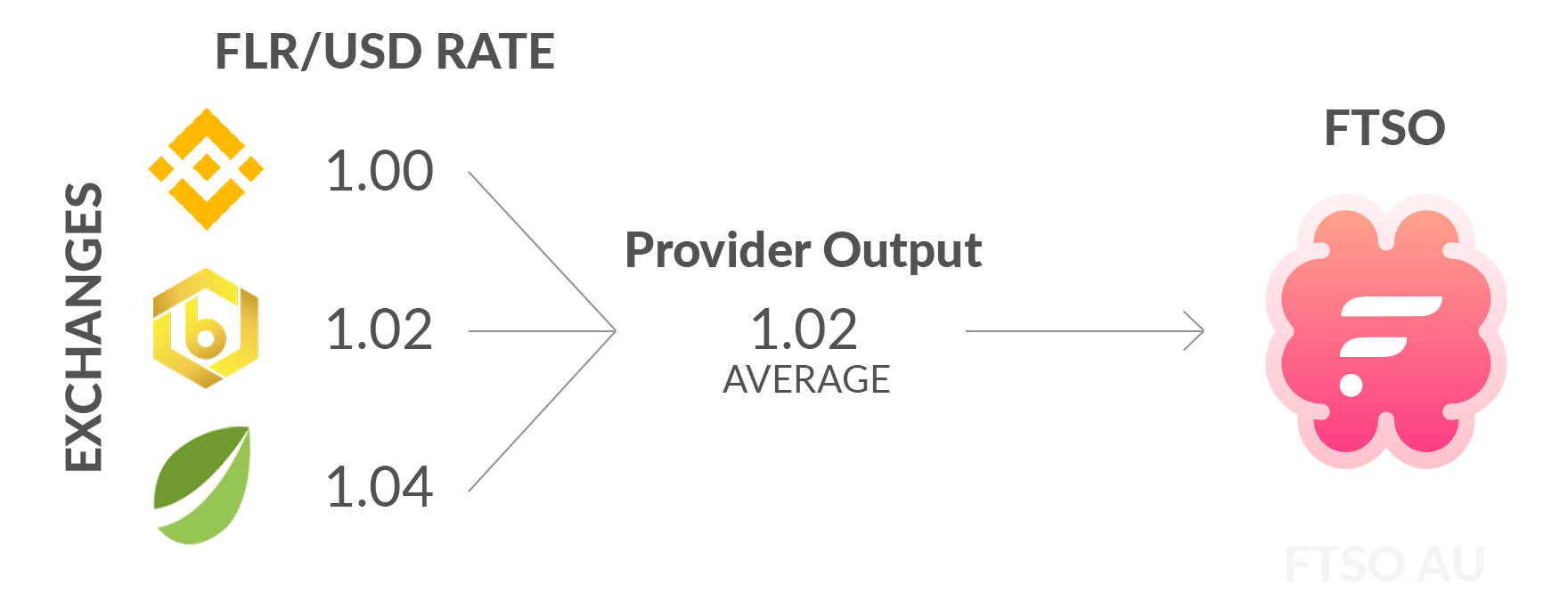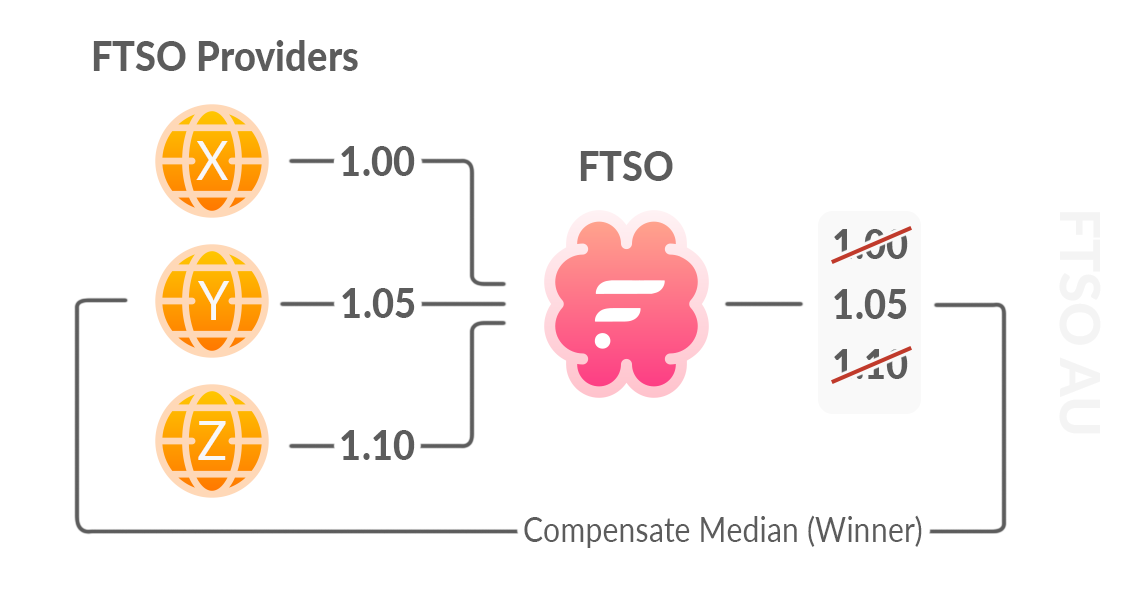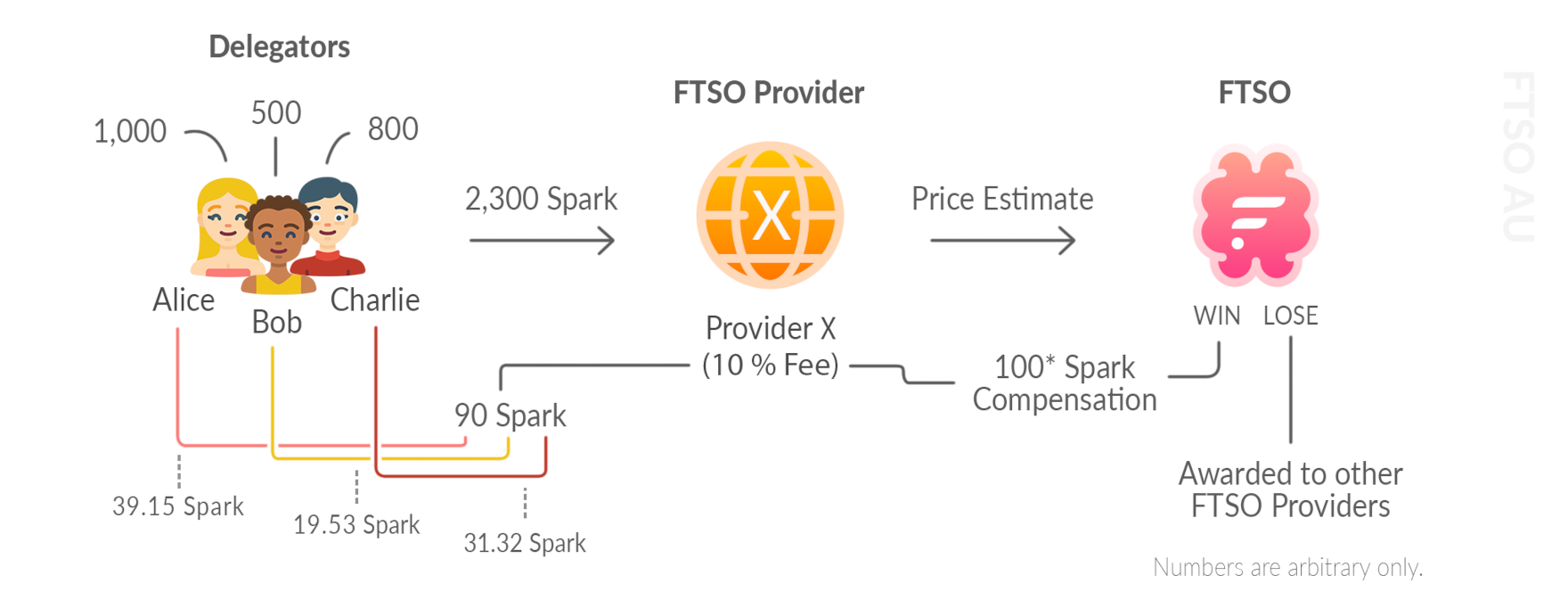How The FTSO Works | Flare Networks
A little talked about feature of Flare Networks is the Flare Time Series Oracle (FTSO). It's the heartbeat of the network outputting various pair prices such as the FLR/$ and XRP/$ price.
Flare Networks needs data from outside of its own network, specifically price data of various token/$ pairs. It is important that this data is sourced in a decentralised manner as to not disqualify the entire network itself from becoming centralised, hence the need for the FTSO.
The FTSO itself does not source data but rather has Spark and F-Asset holders vote on data that data providers source. The FTSO then processes this data and outputs a price based on a few formulas.
So how does the FTSO actually work?
We all want to know how we can earn passive income from the FTSO but first, we need to find out what’s involved.
For the FTSO to operate we can breakdown what's involved:
~ FTSO providers (otherwise known as Data providers)
~ Delegators (Spark token & F-Asset holders)
~ Voting rounds (every 𝑥 minutes)
~ Compensation/Rewards
FTSO Provider
It all starts with FTSO providers who source price data for token pairs using their own proprietary methods. As an example, a provider may collect the price of XRP/$ from three different exchanges, average the price and have this price estimate ready for the FTSO every voting round to submit.
This is all done programmatically.

Not every FTSO provider will operate in this way, they may source and calculate their price estimate in whichever way they choose and believe will be accurate.
Delegators
In order for a price estimate to be submitted to an FTSO, it must be voted upon, this is where Spark and F-Asset holders come in and vote for a particular price estimate. Every Spark is counted as one vote (1:1). F-Asset’s can also be used to vote for the corresponding token pair (eg. FXRP holders can vote for the XRP/$ price or FXLM holders can vote for the XLM/$ price) however F-Asset tokens do not have the same voting ratio and instead are adjusted (see Definition 4.4 in Flare Networks whitepaper).
Anyone can submit price data to the FTSO and vote for their own price estimate but often it won’t be feasible due to the technical skills required. This is why most Spark and F-Asset holders will delegate their tokens to an FTSO provider who they trust will provide accurate price estimates. Delegation will be as simple as logging into a Flare wallet, choosing an FTSO provider and finally selecting the amount tokens they wish to delegate.
It’s important to note that when a delegator chooses to delegate their tokens to an FTSO provider, the tokens will never actually leave their wallet. This provides a risk-free experience for delegators.
Voting Rounds
Based on a governance variable (a variable that is decided by the holders of Spark), voting rounds will occur every 𝑥 minutes. For example, there may be a voting round every minute which results in a total of 1440 voting rounds in a day (24 hours * 60 minutes). FTSO providers should (but aren’t forced to) submit their price estimate every round.
Every voting round there will be a select number of FTSO providers who win the round. To win a round the FTSO provider must send a price estimate to the FTSO which falls in the median of all price estimates submitted in that round. The top 25% and bottom 25% of price estimates are removed from consideration by the FTSO leaving the middle 50% to be considered. Any FTSO provider that submits an estimate in the middle 50% is considered a winner and will be compensated in Spark tokens.
The exact amount of compensation is based on a number of variables (see 4.4 Compensation in Flare Networks whitepaper) and each provider will not be awarded equally.

The compensation is then forwarded to each delegator based on the number of tokens they delegated minus a fee set by the FTSO provider.
For example, Alice, Bob and Charlie choose to delegate their Spark tokens, 1000, 500 & 800 respectively for a total of 2,300 Spark delegated to FTSO Provider 𝑥. FTSO Provider 𝑥 submits their price estimate for the round and wins using their proprietary price estimate. Say, 100 Spark is awarded as compensation to FTSO Provider 𝑥. FTSO Provider 𝑥 will take 10 Spark as a fee (10%) and divide the rest of the 90 tokens to the delegators based on their stake ratio (delegators stake / total Spark delegated to FTSO Provider 𝑥). Thus, Alice gets 43.5% (39.15 Spark), Bob gets 21.7% (19.53 Spark) and Charlie gets 34.8% (31.32 Spark). Note: Only Spark delegators are compensated, F-Asset votes are not compensated by the FTSO.

To sum up the processes:
Delegators holding either Spark or an F-Asset choose an FTSO Provider, based on the FTSO Providers win-rate and fee, then delegate their tokens to that provider.
The FTSO Provider uses their algorithms to determine a price estimate for one (or more) pairs such as FLR/$ or XRP/$. Every round (at an interval set by a governance variable), FTSO Providers submit their price estimates to the FTSO backed by the delegators votes.
If an FTSO Providers price estimate is within the median of all price estimates in a given round, the FTSO Provider will win the round (alongside any other FTSO Providers who fall in the middle 50%).
The FTSO will disproportionately distribute compensation in Spark to all winners based on the compensation variables (see 4.4 Compensation in Flare Networks whitepaper).
The winning FTSO Providers will take a cut of the compensation as a fee and distribute the remaining Spark to all their delegators.
What’s the best way to earn passive income?
There are two ways to earn from this system:
Be an FTSO Provider
If you know how to program, use API’s and interact with the blockchain using technology such as Web3 you can build your own FTSO Provider. As well as building the software, you’ll also have to build a community that trusts your software and will delegate tokens to you.
Delegate Your Tokens
If you hold Spark tokens you may want to consider choosing an FTSO provider to delegate your tokens to. It’s by far the easiest way to earn passive income with only a few clicks. Your earnings will be based on the performance of the FTSO provider, so choose wisely.
If you hold an F-Asset you can also delegate to an FTSO provider, but you will not be rewarded in Spark. This does not mean you won’t find any financial benefit as some FTSO providers may offer incentives for your vote.
FTSO Providers will become a diverse market offering a range of benefits outside of just Spark compensation. FTSO Provider value all the votes they can get (which includes F-Asset votes) which means everyone who can provide a vote will be rewarded in some way.
To find a list of all currently operating FTSO’s, visit FlareMetrics.
You can also watch this content on Tim's Youtube Channel.
The FTSO is currently not publically operating (as of 29 April, 21) but will come available on the Flare Networks beta shortly.